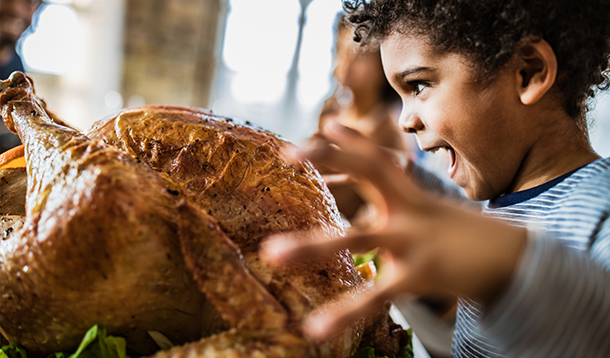
Many home cooks dread the Thanksgiving holiday each year. They aren't intimidated by the large crowd coming over, or the multi-course meal they need to prepare, it's the turkey that keeps them up at night with the sweats. Nothing will spoil a Thanksgiving dinner like ruining the star of the show. So how do you make sure you get a perfectly cooked turkey at your Thanksgiving meal?
Turkey cooks from the outside in. The trick is that you want the heat to permeate through and cook the whole bird to the perfect temperature without overcooking it. If you use too high of a heat or leave it for too long, you'll burn the skin and dry out the turkey. If you use too low of a heat or don't leave it roasting for long enough, you'll end up with rubbery skin and raw turkey. Neither of these scenarios are going to win you any accolades with your guests.
Finding that sweet spot is as easy as 1 . . . 2 . . . 3 . . . I use the basic steps of a classic Alton Brown recipe that has never failed me.
Make sure your turkey is entirely defrosted before you begin. This may take days in the fridge or hours in cold water. Make sure you leave yourself enough time and never, ever defrost your turkey on the kitchen counter. Do so and you'll be inviting a host of bacteria to your Thanksgiving dinner. When you begin, your turkey should be at fridge temperature (~38F).
We are going to brown the skin of the turkey right off the bat and then cover it with foil to protect it from over-cooking. This takes the guess work out of perfectly cooked skin and the only thing we need to worry about is making sure our turkey is cooked through. Remove all oven racks except for one in the next-to-the-lowest position. Preheat the oven to 500°.
Liberally rub some butter or olive oil between your hands until greased. Rub grease into the turkey. You may need to re-grease your hands a couple times in order to coat the turkey. Salt and pepper the inside and outside of your turkey. Loosely pack the turkey with a combination of aromatics (fresh herbs, carrots, celery, and onion). Note: we are using these as aromatics for the turkey. They will be discarded afterwards. Never cook your stuffing in your turkey. I know it sounds like a glorious idea, but the temperature you need stuffing to get to inside the cavity of the turkey will only make for an overcooked, dry turkey. Make your stuffing in a casserole dish.
Place the turkey, breast side up, on a rack set inside a large roasting pan. Cut a piece of aluminum big enough to cover the turkey's breast. Mold this piece to the breast. Remove it and oil the foil with non-stick vegetable spray. Set aside.
Place the turkey in the oven, breast side up. Roast the turkey until nicely browned, 30–40 minutes.
So now that we've browned the skin, we're faced with the golden question — how long should I cook it for? The doneness of any meat is a factor of one thing and one thing only — the internal temperature. This is true for anything you cook from turkey, to steak, or standing rib roast. Don't let anyone tell you otherwise! So, you're going to need a probe thermometer for this next part.
Once the turkey has browned, remove from the oven and apply the pre-molded aluminum foil to the breast of the turkey. Insert a thermometer probe directly through the foil into the deepest part of the breast. Reduce the oven temperature to 350° and return the turkey to the oven, foil securely in place. Do not open the oven to baste the turkey. Roast the turkey until the probe reads 161°. This will take about 2 1/2 hours for a 15lb turkey, but remember, there is no magical calculator or online tool that can figure out how long to roast your turkey. They can give you estimates, but every oven and turkey are different. The turkey is done only when the turkey is done. And as we just discussed, this is ONLY a measure of temperature. So, make sure you leave yourself plenty of time for the turkey to cook, and if it's done a little early, it will hold its temperature nicely if you tent it with aluminum foil.
Your turkey will be perfectly cooked once the breast temperature reads 161F. You can now test the thigh. It should read about 180F. Take the turkey out of the oven, cover with aluminum foil, and allow it to rest for 20 to 30 minutes. By resting, you'll make sure the turkey remains juicy when slicing. Save the pan drippings for gravy and carve the turkey. You're a Thanksgiving superhero!